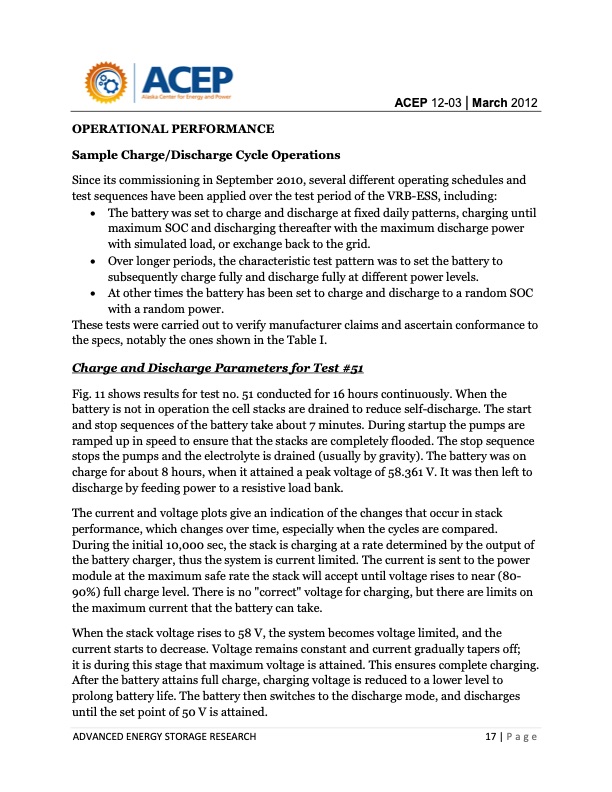
PDF Publication Title:
Text from PDF Page: 029
OPERATIONAL PERFORMANCE Sample Charge/Discharge Cycle Operations Since its commissioning in September 2010, several different operating schedules and test sequences have been applied over the test period of the VRB-ESS, including: • The battery was set to charge and discharge at fixed daily patterns, charging until maximum SOC and discharging thereafter with the maximum discharge power with simulated load, or exchange back to the grid. • Over longer periods, the characteristic test pattern was to set the battery to subsequently charge fully and discharge fully at different power levels. • At other times the battery has been set to charge and discharge to a random SOC with a random power. These tests were carried out to verify manufacturer claims and ascertain conformance to the specs, notably the ones shown in the Table I. Charge and Discharge Parameters for Test #51 Fig. 11 shows results for test no. 51 conducted for 16 hours continuously. When the battery is not in operation the cell stacks are drained to reduce self-discharge. The start and stop sequences of the battery take about 7 minutes. During startup the pumps are ramped up in speed to ensure that the stacks are completely flooded. The stop sequence stops the pumps and the electrolyte is drained (usually by gravity). The battery was on charge for about 8 hours, when it attained a peak voltage of 58.361 V. It was then left to discharge by feeding power to a resistive load bank. The current and voltage plots give an indication of the changes that occur in stack performance, which changes over time, especially when the cycles are compared. During the initial 10,000 sec, the stack is charging at a rate determined by the output of the battery charger, thus the system is current limited. The current is sent to the power module at the maximum safe rate the stack will accept until voltage rises to near (80- 90%) full charge level. There is no "correct" voltage for charging, but there are limits on the maximum current that the battery can take. When the stack voltage rises to 58 V, the system becomes voltage limited, and the current starts to decrease. Voltage remains constant and current gradually tapers off; it is during this stage that maximum voltage is attained. This ensures complete charging. After the battery attains full charge, charging voltage is reduced to a lower level to prolong battery life. The battery then switches to the discharge mode, and discharges until the set point of 50 V is attained. ADVANCED ENERGY STORAGE RESEARCH 17 | P a g e ACEP 12-03 | March 2012PDF Image | Advanced Battery Storage Systems Testing at ACEP VRB ESS

PDF Search Title:
Advanced Battery Storage Systems Testing at ACEP VRB ESSOriginal File Name Searched:
ACEP-VRB-Testing-Report.pdfDIY PDF Search: Google It | Yahoo | Bing
Salgenx Redox Flow Battery Technology: Salt water flow battery technology with low cost and great energy density that can be used for power storage and thermal storage. Let us de-risk your production using our license. Our aqueous flow battery is less cost than Tesla Megapack and available faster. Redox flow battery. No membrane needed like with Vanadium, or Bromine. Salgenx flow battery
| CONTACT TEL: 608-238-6001 Email: greg@salgenx.com | RSS | AMP |